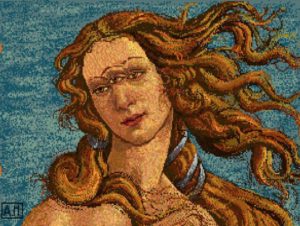Elizabeth Moroni | June 2018
Andy Warhol was a machine-tirelessly generating art that spanned across all genres, from his childhood to his death. His body of work is so vast, it is nearly impossible to estimate just how many pieces he produced. Some pieces he gave as gifts; others were lost and forgotten. Until, by a stroke or two of shimmering luck, they were found.
It is not unusual for a Warhol to be hidden. The owner of such a precious treasure may store it for safekeeping but miss the chance to collect its value, or even the chance to tell another soul of its hiding place. It is natural to be reminded of a pirate’s bounty, buried and forgotten until some lucky man’s metal detector chirps with recognition. Once a Warhol is floating unknown in the world, it is hard to tell who the lucky discoverer may be. You may just be a woman from New Jersey in need of a couch.
[visual_three_fourth]
The woman, who requested to be unnamed, had answered to a craigslist ad regarding a $200 couch. She got in her car and drove to the Lower East Side of Manhattan, where she was not only greeted with the expected couch but also a box of miscellaneous items. “It’s junk,” the seller reportedly informed her. She could take the box for free if she wanted. And so, she hoisted the box into her car and drove it back home, along with her new piece of furniture. It was there that she realized she was the new owner of a 1977 Warhol: an erotic screen painting of a man’s penis, washed with distinct color blocks of warm pinks and cool greens and blues.
Hidden inside frames, unrecognized among junk…imagine the Warhols that have yet to be found! But where to look? Where is the most unexpected place a Warhol could be hiding? It may surprise you to hear that not all of Warhol’s art was tangible.[/visual_three_fourth] [visual_one_fourth_last]
[/visual_one_fourth_last]
When you consider Warhol’s body of work, it’s safe to assume that his most treasured tools were paints, printing presses, pens, and maybe a dozen Polaroid cameras. But the 80’s was the birth of a series of new and innovative technologies. It isn’t accurate to assume that Warhol wouldn’t take advantage of a new art form if he had the chance.
[visual_one_third]

Commodore International’s Amiga 1000 was a personal computer with creative capabilities, maybe one of the earliest programs most similar to our recently beloved Adobe Creative Suite.
Warhol himself had one of these computers, now lovingly cared for and stored by the Andy Warhol Museum in Pittsburgh. Unknowingly stored on dozens of floppy disks were original, unseen Warhol pieces, and they were deteriorating by the second.[/visual_two_third_last]
An ambitious team lead by artist and Warhol enthusiast Cory Arcangel ensured through careful extraction that the artwork was unharmed during the tedious transfer from old to modern hardware. What they found was nothing short of incredible.
“No one had ever attempted to see what was on them. It was a complete mystery what they contained,” Arcangel stated. One piece reflected Warhol’s most recognized Campbell’s Tomato Soup cans, drawn sloppily with a simple line tool. Another features a three-eyed Venus from Botticelli’s The Birth of Venus. Most memorably, an iconic self-portrait, digitized. The efforts of Arcangel’s team bring us Warhol creations that have never been seen before.


There are many who criticize Warhol’s art, but steadfast against the criticism stood a cool Andy surrounded by countless friends. He knew just about everybody. Among them was Cindy Lang, featured in issue #2 of Interview Magazine, who happened to also be dating the up-and-coming Alice Cooper at the time. It was 1970; Lang had asked Cooper’s manager to purchase the most “metal” Warhol painting, a dark, blood red painting titled “Electric Chair”. She planned on gifting it to Cooper for an upcoming birthday, referencing a stage prop electric chair that Cooper would pretend to be electrocuted in during shows. Cooper ended up being admitted to rehab and forgot about the painting. Nearly five decades later, he would find the painting rolled up among old props. “You should have seen Alice’s face when Richard Polsky’s estimate came in,” Cooper’s manager told BBC, adding: “His jaw dropped and he looked at me: ‘Are you serious? I own that!'”
You never know where you may find a Warhol. But one thing is for certain; there is still a chance you may stumble across a long-lost painting in the most unexpected place, all thanks to Warhol’s insatiable need to create as much art as he possibly could.



